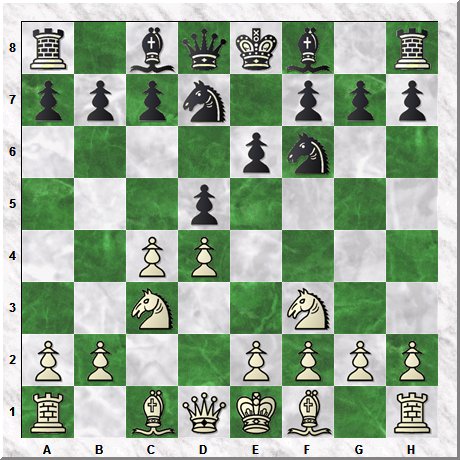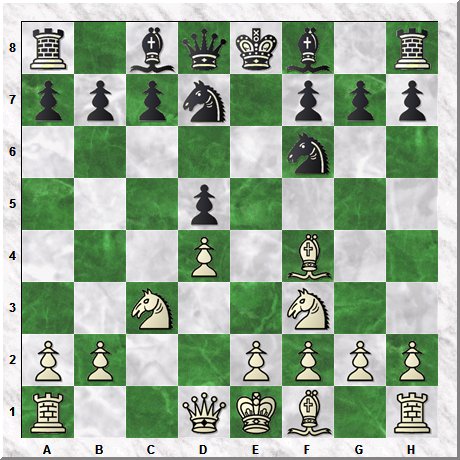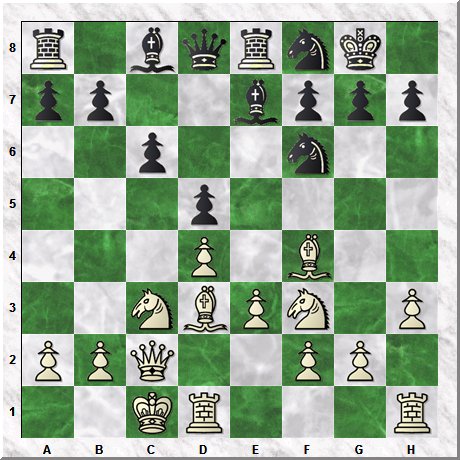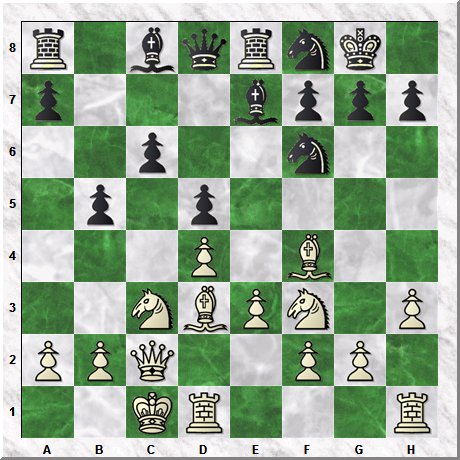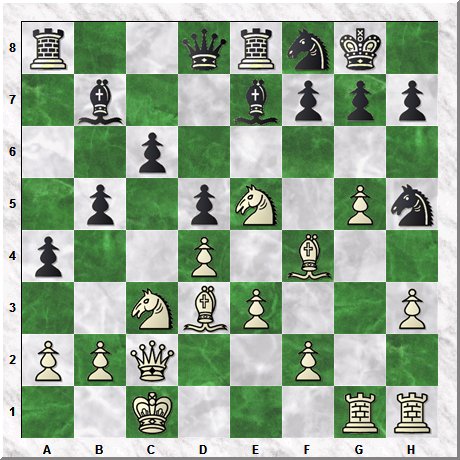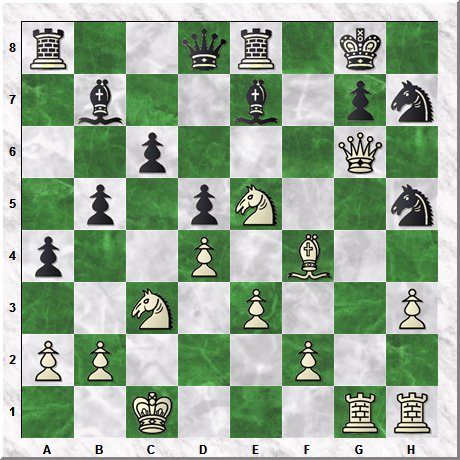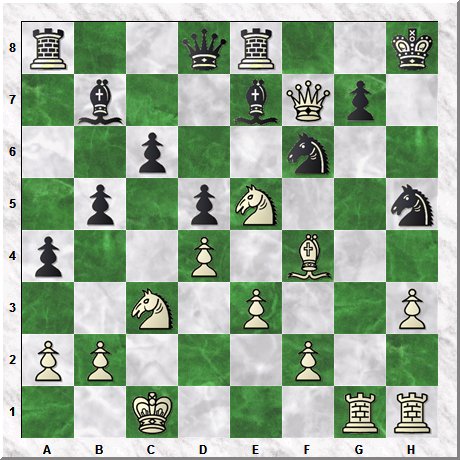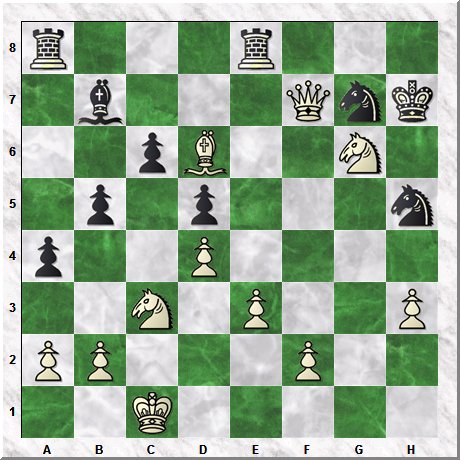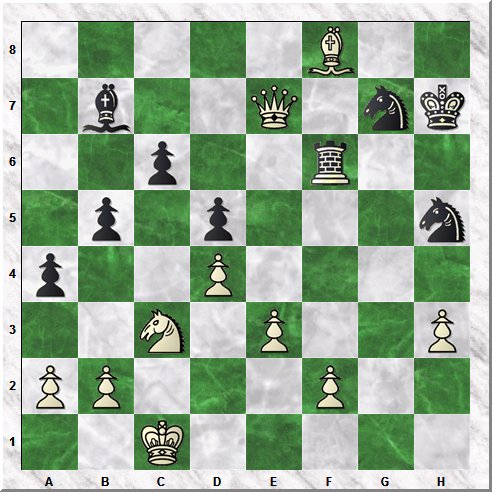All
the |
(Navigation bar
directly below.)
*******
© A.J. Goldsby, 2015.
(All rights reserved.)
****************
Click HERE
to see my
Chess Items.
****************
****************
Buy a book
from Amazon.com
(And help me out as well!)
****************
Click HERE
...
to see a list of the businesses that help to sponsor all of
my chess efforts.
|
|
|
Monday; February 23rd, 2015: I first saw this game many years ago, I think it was in an old book of master games - I even forget who the author was. I was taken with the beauty and the brilliance of this game then, I am still enraptured by this game ... even today. Then ... many years later ... it was the first game in a book that I enjoyed a great deal ... many people said (to me) that they felt that both FM Steve Giddins and I had similar teaching styles. (A compliment to me, to be sure!) This past Saturday, I (once more - for the umpteenth time!) taught this game to a new student (Eric N.) at "Books-A-Million" (The North Davis location.); in Pensacola, FL. I decided that day that I must do a web page on this game - the sooner, the better! (I had annotated this game on my hard drive in 2007, however, it was poorly and quickly done, and I never got around to cleaning it up and then making a web page out of it.) |
|
Click HERE to see an explanation of the symbols that I commonly use when I annotate any chess game. Click HERE to replay this game. (Click HERE to see a "star-dot-pdf" / Adobe copy of my analysis.) Click HERE to see my video channel on the "You-Tube" channel. (Click HERE to see my YT video on this game.) |
Y. Averbakh -
A. Sarvarov
|
|
|
[A.J.G.]
An absolutely fantastic game by GM Yuri Averbakh, I saw this game in an older book (or magazine) many, many years ago.
Sarvarov was a master who once drew Smyslov when he was near the height of his powers in the mid-1950's. Sarvarov also specialized in the Cambridge Springs Defense. (1.d5, d5; 2.c4, e6; 3.Nc3, Nf6; 4.Bg5, Nbd7; 5.Nf3, c6; 6.e3, Qa5.) Sarvarov was an Uzbeki player who played for his team in the Olympiads.
1.c4, (English)
Most GM's use this to sidestep
certain openings they don't want to see and force the game into standard QP openings.
(By transposition.)
I think, although I am not
sure, that Sarvarov liked to play a few Indian Defenses. If so, then 1.c4!,
was an attempt {by White} to steer the game back
into classical channels. If this indeed was the case, then this game is a testament
not only to Averbakh's skill, but also a tremendous voucher for his grasp of chess
psychology and overall judgment of these matters!
[ The normal move order to reach QP openings would be: 1.d4 d5; 2.c4 e6; etc. ]
Play now continues in pretty much standard lines for a QP opening.
1...e6; 2.d4 d5; 3.Nf3 Nf6; 4.Nc3 Nbd7;
It is obvious that Black is trying to head for his favorite opening here, but Averbakh crosses him up.
|
|
r1bqkb1r/pppn1ppp/4pn2/3p4/2PP4/2N2N2/PP2PPPP/R1BQKB1R w KQkq - 0 5
Since Black has already (voluntarily) shut in his own QB, Averbakh just helps things along.
5.cxd5! exd5; 6.Bf4!,
Because of the move order, Black cannot contest the WB on f4. Therefore Averbakh heads for a line that is very aggressive, clearly in the 1st player's favor ... and was probably the result of pre-game preparation. (White plans a possible Q-side castle followed by a brisk attack. This means a Pawn storm ... and if White played his Bishop to the g5 square, it would only interfere with that plan.)
|
|
r1bqkb1r/pppn1ppp/5n2/3p4/3P1B2/2N2N2/PP2PPPP/R2QKB1R b KQkq - 0 6
Black will be forced - probably sooner than later - to play ...c7-c6; in an effort to meet the threat of a possible Nb5 by W.
[ Also possible was: RR 6.Bg5, "+/=" (slight plus for White) which is the Exchange Variation. ]
6...c6; 7.Qc2! Be7; 8.e3 0-0; 9.Bd3 Re8; 10.h3! Nf8; 11.0-0-0, ('!?' Maybe - '!')
Both sides have castled on opposite wings. In such situations, it becomes a race to mate the enemy King, with victory usually going to the side that can
first open a major line to the leader of the opponent's army.
|
|
r1bqrnk1/pp2bppp/2p2n2/3p4/3P1B2/2NBPN1P/PPQ2PP1/2KR3R b - - 0 11
The die is cast, both sides are forced to attack as quickly and as vigorously as humanly possible.
[ Also possible was: RR 11.0-0 Ng6; 12.Bg3, "+/=" (plus for W) ]
Here, most engines choose 11...Ne6; as a good move for Black.
11...b5!?; (Pawn Storm)
In games where players have castled on opposite sides of the board, the normal method of attack is to simply rush your Pawns down the side of the board where the enemy King is located, in an effort to open as many lines as quickly as possible.
|
|
r1bqrnk1/p3bppp/2p2n2/1p1p4/3P1B2/2NBPN1P/PPQ2PP1/2KR3R w - b6 0 12
So while White is advancing his Pawns on the K-side, (in an attempt to open lines); Black pursues a similar idea on the Q-side.
***********************************************************************************************************
Please note that NEITHER SIDE plays a lot of defensive moves ...
ANY Pawn advance (in the vicinity of either King) in an attempt to slow down the onrush of foot-soldiers - in the end - only helps the opponent further their own goals, (For example, 12.a3?, only provokes Black to play 12...a7-a5; threatening ...b5-b4; and if White captures on b4, Black retakes with the Pawn, opening the a-file and gaining a tempo off the Knight on c3 ... which is forced to move, as the second player would now be threatening to play ...PxN/c3.
RULE: The majority of the time, when involved with attacks on opposite sides, pushing Pawns in front of your own King only helps your opponent open
lines which can be used - by your opponent - to further his/her attack against your King!)
12.Ne5! Bb7!?; 13.g4! a5; 14.Rdg1 a4; (Q-side)
If given enough time, Black is all set to play ...Qa5; and then ...b5-b4; with a healthy attack of his own.
[ Black probably should not play the continuation of:
(</=)
RR
14...b4!?;
15.Na4, "+/="
and now White's Knight on a4 has an outpost on c5 and also helps block Black's P-storm
on the Queen-side. (White has a small - but
solid - advantage in this position.) ]
15.g5 Nh5!?; (error?)
Black intentionally plays his Knight to the h5-square in an effort to slow down White's coming Pawn storm.
|
|
r2qrnk1/1b2bppp/2p5/1p1pN1Pn/p2P1B2/2NBP2P/PPQ2P2/2K3RR w - - 0 16
Black has several problems:
#1.) His Knight on h5 is now a liability and a hanging piece.
#2.) His pieces are not on great squares, especially his QB on the b7-square ... which is completely out of play for the forseeable future.
#3.) His opponent is on the move and has a fantastic and powerful initiative.
[
It would have been better to play:
>/= 15...N6d7!;
16.Bxh7+!! Nxh7;
17.g6! Nxe5!; 18.gxh7+ Kh8;
19.Bxe5 Bf6;
"~" (Unclear.)
when - according to the strong engine - DF14 - Black gets a relatively playable game here.
]
Now White breaks through to the Black King in really spectacular fashion.
(NOTE: Open lines are most important, considerations like the material balance are of much less value than is normally the case.
16.Bh2, would have allowed 16...a3; when Black is right back in the fight.)
16.Bxh7+!! Nxh7; 17.g6! fxg6; 18.Qxg6, ± ('+/') ["--->" (With a few threats.) ]
White has broken through to the enemy King first, please note that the hanging Black Knight on h5 ...
and if it moves, White will deliver an instant mate on g7.
|
|
r2qr1k1/1b2b1pn/2p3Q1/1p1pN2n/p2P1B2/2N1P2P/PP3P2/2K3RR b - - 0 18
It is hard to believe, but according to the chess engines, Black is already lost!
*************************************************************************************************
Black's next move is forced ... anything else will get Black mated or drop a piece for free.
18...N7f6[]; 19.Qf7+ Kh8[];
This was 100% forced.
|
|
r2qr2k/1b2bQp1/2p2n2/1p1pN2n/p2P1B2/2N1P2P/PP3P2/2K3RR w - - 0 20
Now White has a forced win, and it is one that Averbakh does not miss.
[ Even worse would be:
</=
19...Kh7?;
20.Rg6! Ng8[];
Again, this was forced.
(</= 20...Rf8??; 21.Rh6#.)
21.Rxg7+! Nxg7; 22.Qg6+ Kh8; 23.Nf7#. (Mate.) ]
White's next move is a text-book example of denuding/removing the Pawn cover in front of the enemy King!
(20.Bh6!, was a rather routine win for White.)
20.Rxg7!! Nxg7; 21.Rg1! Nfh5[];
Again, this was forced, Black had no choice at all. (Black had to try and meet the threat of 22.QxN/g7#.)
[ Of course not: </= 21...Ngh5??; 22.Ng6#.
*****************************
Also very bad would have been:
</= 21...Rg8;
22.Ng6+ Kh7;
23.Nxe7 Qd7;
What else? (Resignation!? If ...Qe8; then Qxf6. '+-')
24.Qg6+ Kh8; 25.Qh6+ Nh7; 26.Ng6#. (Check-mate.) ]
White's next move threatens a very simple mate-in-one.
22.Rg6! Qd6[]; (Forced.)
Black's last move was the only way to prevent White from playing the easy finish, 23.Rh6 mate.
23.Rxd6 Bxd6; 24.Ng6+ Kh7; 25.Bxd6, (Winning.)
White now has a won game ... even worse for Black, his position is completely disorganized and the BK is completely exposed.
|
|
r3r3/1b3Qnk/2pB2N1/1p1p3n/p2P4/2N1P2P/PP3P2/2K5 b - - 0 25
Black would have been justified in quitting here.
(This would have made this game an extremely brilliant {near} miniature.)
25...Re6; 26.Nf8+ Rxf8[]; (Box/forced.) 27.Bxf8 Rf6; 28.Qe7!, "+-"
Black Resigns.
|
|
5B2/1b2Q1nk/2p2r2/1p1p3n/p2P4/2N1P2P/PP3P2/2K5 b - - 0 28
(White's dual threats of BxN/g7 and then QxR/f6 and also QxB/b7 cannot both be adequately met.)
A totally brilliant game by one of chess's greatest players/writers.
This game is thoroughly annotated in the excellent book:
"50 Essential Chess Lessons,"
(Game #1) by FM Steve Giddins. (2006)
[ I only point out the more obvious things, if you want complete notes, please refer to FM Giddins' book! And - I must add - if
you consider yourself a student of chess and you feel that there are chess ideas out there that you just are not {yet} able to fully
grasp, then you owe it to yourself to buy a copy of Giddins' book!
(I highly reccomend this book!) ]
{One master - several years ago, just after the book by FM Steve Giddins came out - emailed me and told me that he thought that Averbakh's game was mostly pre-game prep ... mostly because it is so flawless. He gave several other reasons why he thought this was true - I don't remember them all and I did not save the e-mail. It is entirely possible that this game was the result of "home cooking" ... however, without any proof ... one way or the other ... we can only speculate on what actually occurred in this game. Averbakh's ability was huge, and he has left behind a decent body of games to show that, on his best days, he could play with anybody.}
Copyright (c) A.J. Goldsby, 2007. All rights reserved.
(This game was first
annotated - by me, on my PC - in 2007.)
1 - 0
If you are curious and want to see the picture that I used for the background of this page, then click here.
Make sure you watch my video on this game ... I cover several things there that are not covered here.
See my blog on www.chess.com, (about this game).
The analysis for this page was prepared with the excellent program,
ChessBase
10.0. (I also have CB 11 and CB
12.)
---> My main engine - for this game -
was Deep Fritz 14. (I have a lot of confidence in this engine.)
I also - routinely - check my analysis
with the following programs: Houdini 3.0, Rybka 4, Fritz 13 and Deep Shredder.
The HTML was polished with several different tools and programs, (mostly FP) ... the text was checked for spelling with MS Word.
If you enjoyed this web-page, please e-mail me any comments!
|
Go ... or return ... to my Home Page for this site. Go (or return) ... to my "Annotated Games" (II) Page. Go
... or return ... to my "Best
Games" Page. ******* Copyright
(c) LM A.J.
Goldsby I ******* This
page was first generated in: February,
2015. |

